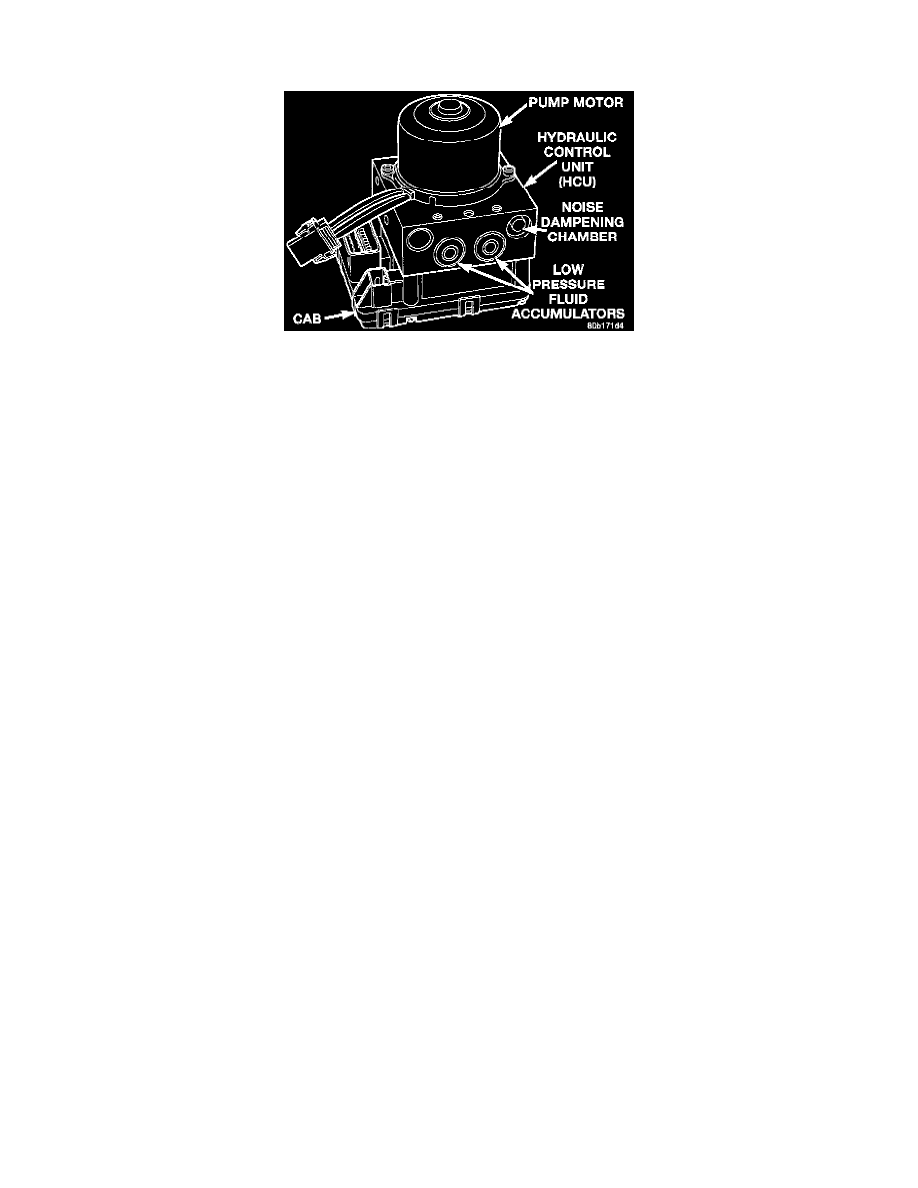LHS V6-3.5L VIN G (1998)

Electronic Brake Control Module: Description and Operation
GENERAL INFORMATION
Controller Antilock Brake (CAB)
The Controller Antilock Brakes (CAB) is a microprocessor based device which monitors the ABS system during normal braking and controls it
when the vehicle is in an ABS stop. The CAB is mounted to the bottom of the Hydraulic Control Unit (HCU). The CAB uses a 25 way electrical
connector on the vehicle wiring harness. The power source for the CAB is through the ignition switch in the Run or On position. THE (CAB) IS
ON THE CCD BUS
The primary functions of the (CAB) are:
1. Detect wheel locking or wheel slipping tendencies by monitoring the speed of all four wheels of the vehicle.
2. Illuminate the TRAC lamp in the message center on the instrument panel when a traction control event is occurring.
3. Control fluid modulation to the wheel brakes while the system is in an ABS mode or the traction control system is activated.
4. Monitor the system for proper operation.
5. Provide communication to the DRB Scan Tool while in diagnostic mode.
6. Store diagnostic information.
7. The CAB continuously communicates with the body controller by sending out a message to the body controller on the CCD Bus. This message
is used for illumination of the yellow antilock warning lamp. This is used if the ABS controller communication is lost in the hard wire between
the body controller and the yellow antilock warning lamp. If the body controller does not receive this message from the CAB, the body
controller will illuminate the antilock yellow warning lamp.
The CAB continuously monitors the speed of each wheel through the signals generated by the wheel speed sensors to determine if any wheel is
beginning to lock. When a wheel locking tendency is detected, the CAB commands the CAB command coils to actuate. The CAB command coils
then open and close the valves in the HCU which modulate brake fluid pressure in some or all of the hydraulic circuits. The CAB continues to
control pressure in individual hydraulic circuits until a locking tendency is no longer present.
The ABS system is constantly monitored by the CAB for proper operation. If the CAB detects a fault, it will turn on the Amber ABS Warning
Lamp and disable the ABS braking system. The normal base braking system will remain operational.
The CAB contains a self-diagnostic program which will turn on the Amber ABS Warning Lamp when a ABS system fault is detected. Faults are
then stored in a diagnostic program memory. There are multiple fault messages which may be stored in the CAB and displayed through the DRB
Scan Tool. These fault messages will remain in the CAB memory even after the ignition has been turned off. The fault messages can be read and
or cleared from the CAB memory by a technician using the DRB Scan Tool. The fault occurrence and the fault code will also be automatically
cleared from the CAB memory after the identical fault has not been seen during the next 3500 miles of vehicle operation. Mileage though of the
last fault occurrence will not be automatically cleared.
CONTROLLER ANTILOCK BRAKE INPUTS
-
Four wheel speed sensors.
-
Stop lamp switch.
-
Ignition switch.
-
System relay voltage.
-
Ground.
-
Traction Control Switch (If Equipped).
-
Diagnostics Communications (CCD)
CONTROLLER ANTILOCK BRAKE OUTPUTS
-
C2D Communication To Body Controller And Instrument Cluster
-
ABS warning lamp actuation.
-
Traction Control Light (If Equipped).
